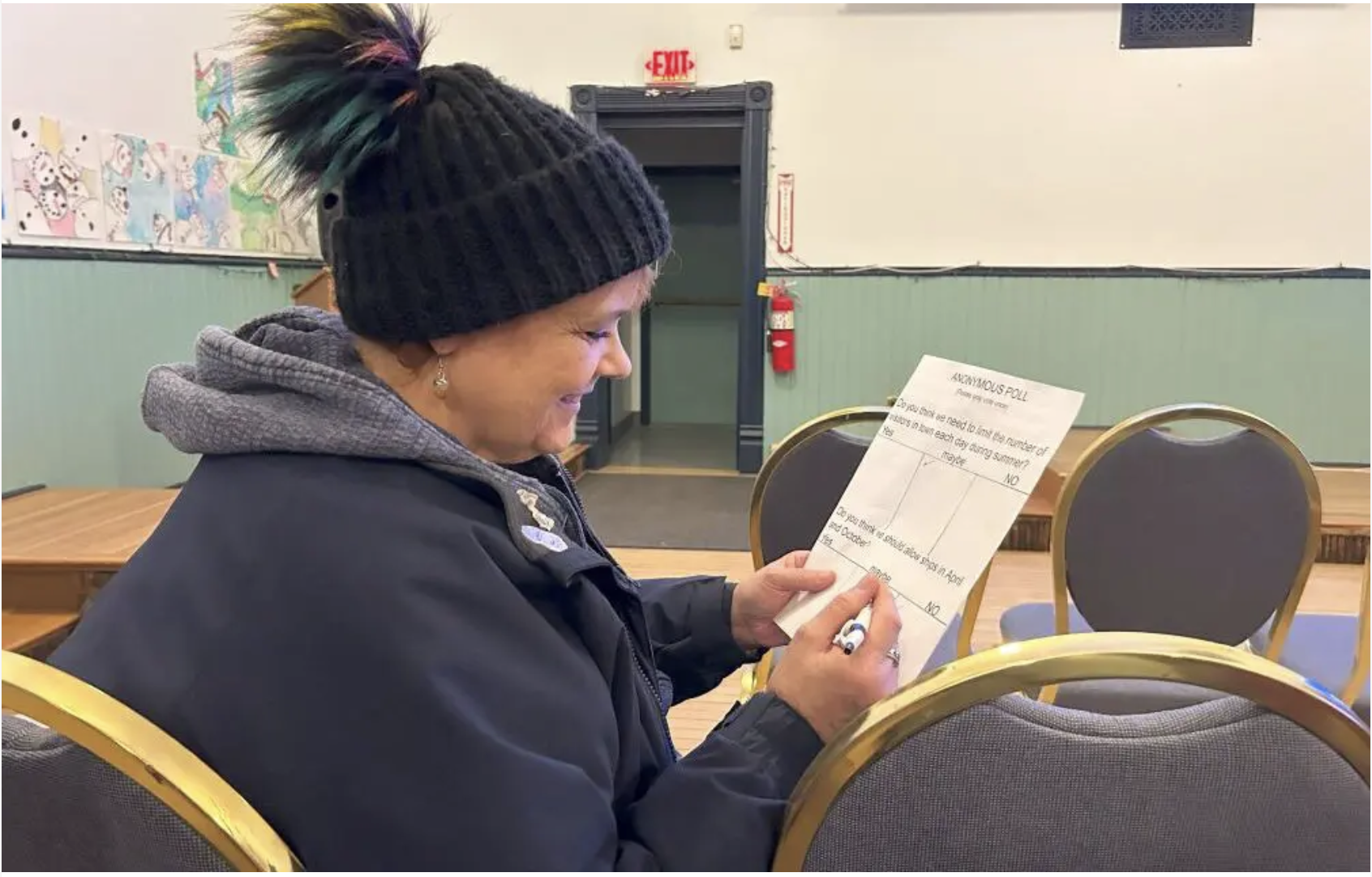There’s a saying Alaskans don’t care how things are done elsewhere, but clearly a standing-room-only crowd of more than 150 people was quite interested in how other places around the world are limiting cruise ship tourism impacts.
But one reality they were told is some of those methods aren’t practical and/or legal in the United States, and thus — to the grumbling of some in the audience — working with the industry is necessary if solutions are going to happen.
“In those countries they’re more socialistic and they depend upon the government to solve the problems,” said Jim Powell, an assistant research professor at the University of Alaska Southeast, presenting his findings during an Evening at Egan event Friday night at UAS. “They don’t go to the industry first…In our country I think you solve the problems by partnerships between the industry because they have a lot of knowledge about what they’re doing. And then also it’s us — it’s the public and the people we elect.”
But a response by one man in the audience during a question-and-answer session at the end of the event was indicative of the skepticism many attendees had about such a concept.
“They totally played us and I don’t really want to be talking about a healthy partnership,” he said, arguing abusive and misleading actions by the industry have occurred locally for many years. “They should be taxed somehow…They pounded our infrastructure. They pounded every single part of it, and our taxes keep going up and up and up.”
“I do not trust these corporations one iota. They are not our partners.”
The crowd packed into the Egan Lecture Hall at UAS to hear Powell’s presentation, watch the documentary “Cruise Boom” about the industry’s impacts on Sitka in 2022 after COVID-19 restrictions were lifted, and participate in the Q&A — with many attendees making impassioned statements rather than asking questions.
The prevailing attitude of the audience was evident from loud applause throughout the room when Power told them Juneau Assembly members cast an informal 6-3 vote on Monday in favor of reducing cruise tourism from the record 1.66 million passengers who visited this year. There were groans of disbelief when Ellen Frankenstein, director of the documentary, said Royal Caribbean is pledging the bigger ships it’s building “are going to be more environmentally friendly.”
“One of the Royal Caribbean reps wanted to see the film and I said ‘come down to the screening and talk with everybody,’ but they didn’t make it,” she quipped.
One person expressing hopefulness about the event as it neared its end — acknowledging it’s “probably going to be an unpopular opinion here” — was Serene Hutchinson, manager of Juneau Tours and Whale Watch, who said “I feel like for the first time I kind of see a little glimpse of what could be possible if we do work together.”
One example, she said, is stakeholders should go beyond focusing on how many cruise ships are in town and consider how long they are in port. She said a megaship that stays half a day, for instance, involves the stressful rushing of fewer passengers for a tour compared to a full day in port when more visitors can participate at a more relaxed pace.
“I was expecting to feel really horrible at this and I don’t, so I appreciate that,” Hutchinson told Powell and Frankenstein. “And please know that I am friends with so many in the industry, and we want to talk and we want to work together. We, just like you, take it very personally because we’re feeding our children through this as well.”
Powell, during his presentation, noted Juneau has taken some pioneering steps to limit cruise tourism impacts including being the first port in Alaska to implement a head tax decades ago, plus the voluntary five-ship-a-day agreement reached with the industry scheduled to go into effect next year.
“There are three others in the world besides us” who’ve signed a similar negotiated operating agreement with the industry, he said.
Among the other ports Powell discussed during his presentation were Bergen, Norway; Visby, Sweden; Akureyri, Iceland; and Nome, which is preparing for a major expansion of both its port capacity and ship activity. He noted Norway has implemented a zero-emissions requirement by 2026 and the Iceland port has imposed a limit of 5,000 passengers a day, but such measures in Juneau pose difficulties.
Putting a set limit on the number of passengers, for example, would likely be illegal due to the right of people to freely travel between states, Powell said, echoing a position taken by many local leaders.
Instead, he said, “my approach really is to look at things in a sustainability format.” He said there has been progress in a variety of ways since cruise ship tourism began its massive expansion during the 1990s — such as best practices agreements, and technology that allows better pollution control and monitoring — but one constant difficulty is “there’s a power imbalance.”
“We’re a small community,” he said. “These are big, billion-dollar industries.”
One way officials in Juneau and other regional ports are working to shift that balance is through partnerships, such as a first-ever “maritime green corridor” aimed at accelerating zero-emission ships and operations between Alaska, British Columbia and Washington. Powell said. Ketchikan, Sitka, Skagway and Haines have also joined the partnership.
Ultimately, Powell said, input from everyone involved will be needed if a balanced approach in the future is going to occur.
“What are the kind of limits of acceptable change?” he said. “What do we want to do? Because the bottom line of all this is if we don’t create our future somebody else is going to create it. And we’ve been managing it for quite a while. But how do we manage it enough? That’s up to us as a community.”
Link to Sitka Sentinel article
Link to article in Juneau Empire



